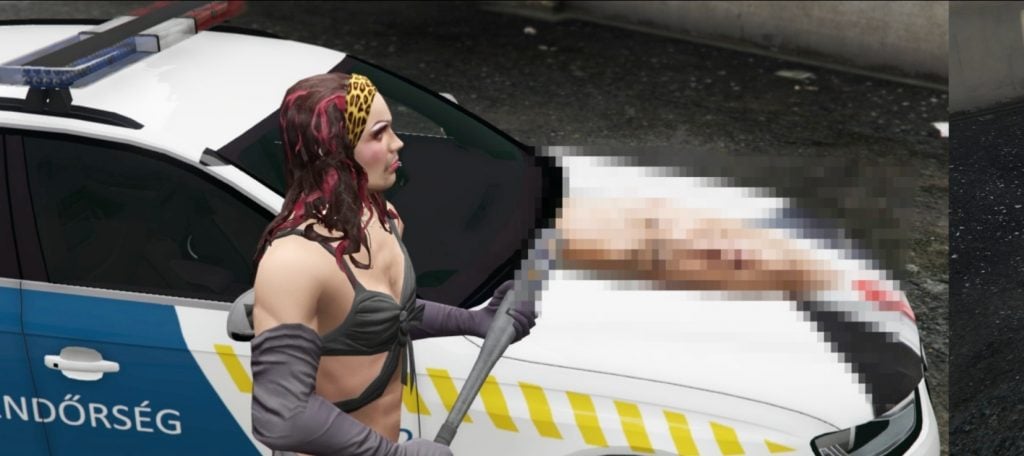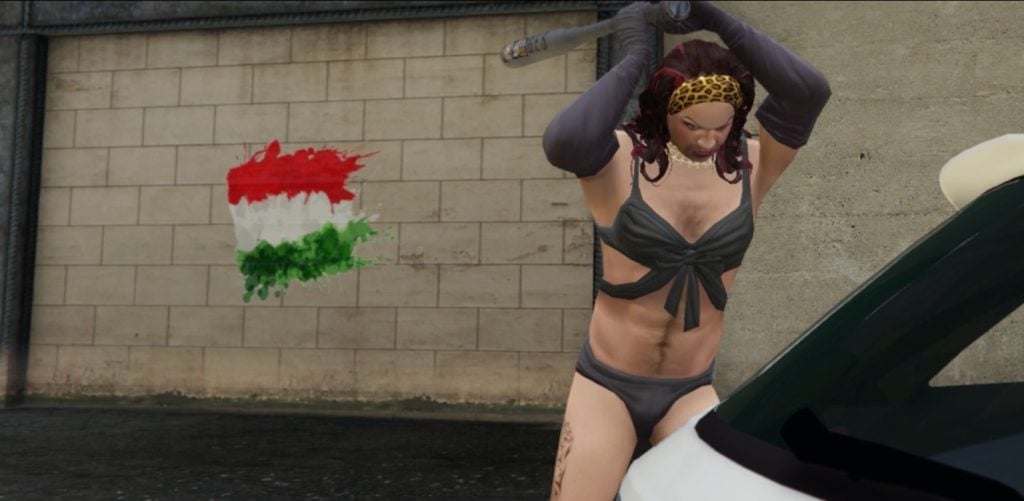A subversive video artwork that criticizes the conservative and anti-LGBTQ+ policies of far-right and autocratic Hungarian Prime Minister Viktor Orbán was apparently censored by an art biennale in Budapest in April. The artist alleges event organizers took issue with the artwork until he submitted a redacted version in which he had blurred the image of the politician.
The short video features a visibly trans-female character dancing and destroying a typical Budapest police car with an image of Orbán’s smiling face on the hood, before getting behind the wheel and knocking it off a cliff. The work is based on a famous Hungarian folk song known as “Gloomy Sunday” and was created especially for the biennale by American activist/artist and self-proclaimed “troublemaker” Grayson Earle.
He was one of 62 artists invited to participate in the BINÁLÉ Digital Art Biennial this spring, under the theme “Queering Democracy”. A letter sent by the curators to potential participants stated, “There is no better time and space to champion the importance of democratic values with the power of art. He also promised: “The binálé is a sovereign and decentralized exhibition in the culturally polarized and politically charged environment of Eastern Europe”.
Earle’s response to the theme was hardly off topic, if not a bit literal. “I wanted to do something specific to the circumstances,” he said, referring to Orbán’s notoriously homophobic policies. In recent years, the Hungarian government has banned same-sex couples from adopting and has fought against LGBT-related themes in children’s media or in school curricula. Orbán was reelected in April 2022. His policies were not directly referenced in any of the other artwork.
“Aspiring fascists like Orbán are so open in their tactics that I wanted to be open with the video as well,” Earle said. “But in an entertaining and also cathartic way.”

Still taken from Grayson Earle, Such a plausible interpretation of “queering democracy” / Szomorú vasárnap, the censored version with Victor Orbán’s face blurred. Screenshot captured with permission from the artist.
Shortly after submitting the work, however, Earle claimed he began causing a stir. “I had an idea it could happen, of course,” he said.
According to one of the biennale’s three curators, Viola Lukács, her co-curator Peter Weiler was the first to oppose it. He brought the work to the attention of the organizers of the Tavaszi Fesztivál, or Budapest Spring Festival, the umbrella event that hosted the biennale and has taken place every year since 1981.
“He expressed concern that this work very directly criticizes the regime and is probably not the best publicity for the whole project,” said Lukács, who grew up in Hungary but left because that she “could feel the suffocation of the taken cultural scene”. through propaganda at the institutional level.
Initially, the organizers told Earle that he would not be able to exhibit a video using a copyrighted song. He re-recorded the backing track to meet their request, the artist said, “knowing that obviously they would have to say that what they were really interested in was for Orbán’s image to be challenged” . When the denial against the artwork persisted, Lukács approached Earle and the pair reached the compromise of pixelating Orbán’s face, although it appears they were never explicitly tasked with obscuring his features. Instead, they allege they felt pressured by Weiler.
“I never knew what would have happened if I said no, but it was kind of a game of chicken,” said Earle, who admitted he was actually happy to censor the work and “to remove the contradictions, let it be a collaboration”. between me and the censor.
Lukács also could not be sure that the festival would have rejected the uncensored work, even after asking its organizers. “They said they didn’t want to interfere, it was our conservation decision,” she recalled, but found their statements vaguely disturbing. “They didn’t want to take responsibility, but they shared Peter’s fear of complications.”
“What is interesting is how subtle the tools of power work, people living in anti-democratic regimes will censor themselves,” Lukács concluded. “It’s an echo of the communist era.”

Still taken from Grayson Earle, Such a plausible interpretation of “queering democracy” / Szomorú vasárnap. Screenshot captured with permission from the artist.
Weiler told Artnet News that he thinks the video could “put us in a situation where the press uses it to brand the binálé as violent, partisan, and vapid,” thereby undermining the exhibit’s “bipartisan goals.” As a conservative, he had hoped to transcend rather than play into the highly polarized political divides he sees in Hungary.
The festival’s artistic director, Máté Gáspár, confirmed to Artnet News that he had spoken to the three curators, noting that they had not reached an agreement on how to handle the work. “No further instructions were given, but to strive for consensus and to mitigate potential risks (if any) that would adversely affect the reception of the entire effort,” did he declare. “I must firmly reject the perception of any ‘censorship’. No complaints were made to us either during the exhibition or after.
There is precedent for an artist facing legal issues after protesting Orbán using his image, which Lukács says was presented to him by festival organizers. In 2013, rapper Dopeman, in conjunction with the Hungarian Solidarity Movement, erected and then toppled a polystyrene statue of the leader in Clark Ádám Square and detached his head, intentionally hitting it in front of a crowd of around 1,000 spectators. He was charged with breach of the peace, but a court found no wrongdoing, according to Hint.
Although not originally from Hungary, Earle considers himself part of an international resistance movement, particularly in light of Donald Trump and Steve Bannon’s involvement in the Conservative Political Action campaign in Budapest in the early days. may. “If I’m in a position where I can hold up better than a Hungarian artist who has more to lose, I’d be happy to do so,” he said.
The artist is certainly no stranger to controversyy. In 2015, his collective projected “KOCH = CLIMATE CHAOS” on the Met to protest a donation to the institution by billionaire David H. Koch. The statement was removed by the NYPD, an action that was later found to violate the First Amendment.
“I think every piece of art is political,” Earle said. “The more art appears to be apolitical, the more powerfully it reinforces the status quo.”
The uncensored version of Such a plausible interpretation of “queering democracy” will be included in a special exhibition organized by Budapest Pride on June 16.
Follow Artnet News on Facebook:
Want to stay one step ahead of the art world? Subscribe to our newsletter to receive breaking news, revealing interviews and incisive reviews that move the conversation forward.
